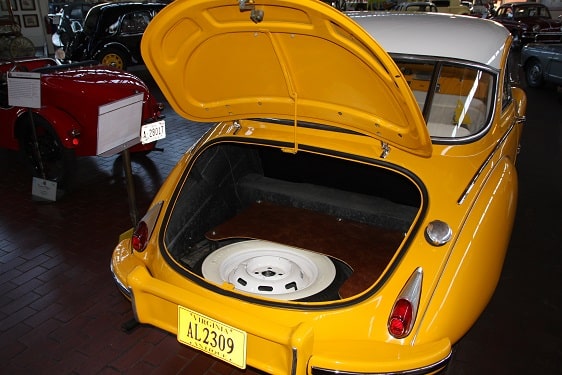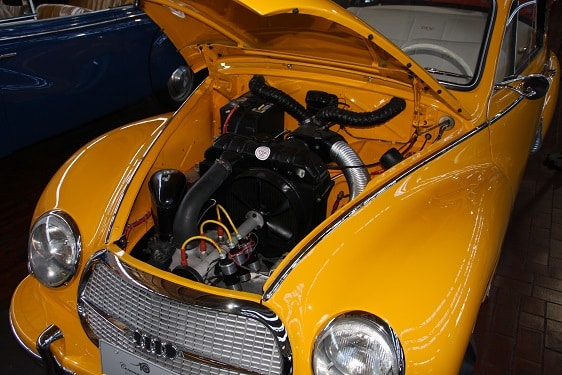
Auto Union 1000- 1958

The name DKW comes from “Dampf‐Kraft‐Wagen” which translates to “steam powered vehicle.”
It carries this name because the first vehicle its Danish designer, J.S. Rasmussen built was a light steam car. Like many other manufacturers, DKW was also famous for motorcycles –in the 1930s they were the world’s largest motorcycle manufacturer. In 1931, DKW diversified into automobile manufacturing. In 1932, they became part of Auto Union, joining Audi, Horch, and Wanderer. In
1949, DKW was re‐established in the Federal Republic of Germany before being taken over by Mercedes‐Benz. Sold to Volkswagen in 1965, DKW became part of Audi, and ceased production
in 1966.
DKW was known for being a reliable, well‐built car. The two stroke engine is small, being under 1000cc, but provided adequate power to move this medium size car along very well. The engine has only 7 moving parts – 3 pistons, 3 connecting rods and a crankshaft. There are 3 coils and 3 sets of points. The distributor is on the end of the crankshaft. The cooling system is a convection type with the radiator mounted higher than the engine so that hot water rises to the radiator while cooled water returns to the engine from the lower radiator outlet. Amazingly, this arrangement drops the water temperature 40° F. The fan is mounted on top of the head, facing the rear, and provides not only cooling air to the radiator but also serves as the heater for the car. A damper on the back side of the radiator is controlled by a push rod to enable the driver to block off part of the radiator to make the engine heat up to operating temperature in cold weather. There is also a manually operated screen, similar to a window shade that can be pulled across the front grill to further limit the amount of cooling air reaching the radiator.
The four speed manual transmission has the shift lever mounted on the column. Also, ahead of its time, the headlight dimmer switch is mounted on the column instead of the floor as was common in the 50’s and earlier.
Specifications:
Manufacturer: Auto Union GmbH
Country of Origin: Germany
Drivetrain Configuration: Front engine, front-wheel drive
Engine: 980cc, 2-stroke, 32 HP
Transmission: 4 speed manual
Top Speed: 80-83 MPH
Years of Production:
Number Produced:
Original Cost: $1,675 in 1958
Restoration Cost: $37,320.18
Mechanical Work: Jim Newborn
Body Work: Timeless Auto Works
Jamie Barksdale, owner
South Boston, VA
Interior: Joe Briscoe Upholstery
South Boston, VA
This vehicle was generously donated to the museum by Jim Newborn in honor of his wife, Dee.



